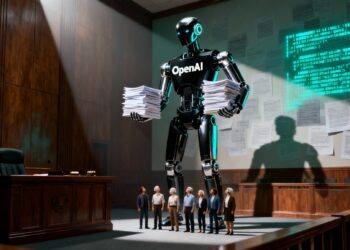Breakthrough Technology Challenges Traditional Large Language Models

A Singapore-based AI startup has just shattered conventional wisdom about artificial intelligence reasoning. Sapient Intelligence recently unveiled their Hierarchical Reasoning Model (HRM), a brain-inspired architecture that’s turning heads in the AI community. This isn’t just another incremental improvement. We’re talking about a system that matches or outperforms massive language models while using a fraction of the resources.
The numbers are staggering. HRM achieves near-perfect accuracy on complex reasoning tasks with just 1,000 training examples. Compare that to the millions or billions of examples that traditional large language models require. Even more impressive? This 27-million-parameter model is delivering results that put much larger systems to shame.
What makes this particularly exciting is the timing. As AI costs continue to skyrocket and companies struggle with the computational demands of current systems, HRM offers a fundamentally different approach. It’s not about building bigger models anymore. It’s about building smarter ones.
The Problem with Current AI Reasoning
Current large language models rely heavily on something called chain-of-thought (CoT) prompting. Think of it as forcing the AI to “think out loud” by breaking down complex problems into step-by-step text explanations. While this approach has improved AI reasoning capabilities, it comes with serious limitations.
The researchers at Sapient Intelligence put it bluntly: “CoT for reasoning is a crutch, not a satisfactory solution.” The problem lies in its brittleness. A single misstep or incorrect ordering of steps can completely derail the entire reasoning process. It’s like watching someone solve a math problem by narrating every single calculation – inefficient and prone to errors.
This dependency on generating explicit language creates another issue. It tethers the model’s reasoning to individual tokens, requiring massive amounts of training data and producing slow, verbose responses. The system essentially has to translate its internal understanding into human language at every step, creating unnecessary bottlenecks.
More fundamentally, this approach misses how humans actually think. We don’t constantly translate our thoughts into words when solving complex problems. Much of our reasoning happens in what researchers call “latent space” – internal, abstract representations that don’t require language translation.
Brain-Inspired Architecture Changes Everything
The breakthrough came when Sapient Intelligence looked to neuroscience for inspiration. The human brain doesn’t process information in a single, linear fashion. Instead, it organizes computation hierarchically across different regions operating at various timescales. This enables deep, multi-stage reasoning that current AI systems struggle to replicate.
HRM mimics this biological structure through two coupled, recurrent modules. The high-level (H) module handles slow, abstract planning – like a strategic commander overseeing the big picture. The low-level (L) module manages fast, detailed computations – similar to tactical units executing specific operations.
This creates what the team calls “hierarchical convergence.” The fast L-module tackles portions of the problem, executing multiple steps until reaching a stable, local solution. Then the slow H-module takes this result, updates its overall strategy, and gives the L-module a new, refined sub-problem to work on.
This process effectively resets the L-module, preventing it from getting stuck in local optima while allowing the entire system to perform long sequences of reasoning steps. It’s elegant in its simplicity and powerful in its execution.
Impressive Performance Results

The proof is in the performance. When tested against benchmarks requiring extensive search and backtracking, HRM delivered results that left traditional models in the dust. On the notoriously difficult Abstraction and Reasoning Corpus (ARC-AGI), HRM scored 40.3% accuracy. This surpassed leading CoT-based models like o3-mini-high (34.5%) and Claude 3.7 Sonnet (21.2%).
But here’s where it gets really interesting. On “Sudoku-Extreme” and “Maze-Hard” benchmarks, state-of-the-art CoT models failed completely, scoring 0% accuracy. HRM achieved near-perfect accuracy after training on just 1,000 examples for each task. That’s not a typo – one thousand examples, not millions.
The efficiency gains extend beyond accuracy. According to Guan Wang, Founder and CEO of Sapient Intelligence, HRM’s parallel processing architecture could deliver up to 100x speedup in task completion time compared to the serial, token-by-token generation of traditional models.
Training costs tell an equally compelling story. The model required roughly two GPU hours for professional-level Sudoku training and between 50-200 GPU hours for the complex ARC-AGI benchmark. That’s a fraction of the resources needed for massive foundation models that often require thousands of GPU hours and millions of dollars in computational costs.
Real-World Applications and Enterprise Impact
While solving puzzles demonstrates technical capability, the real excitement lies in practical applications. Wang suggests that developers should continue using large language models for language-based or creative tasks, but for “complex or deterministic tasks,” HRM-like architectures offer superior performance with fewer hallucinations.
The sweet spot appears to be “sequential problems requiring complex decision-making or long-term planning.” This includes latency-sensitive fields like embodied AI and robotics, where split-second decisions matter. It also extends to data-scarce domains like scientific exploration, where traditional models struggle due to limited training examples.
For enterprises, this efficiency translates directly to bottom-line benefits. Lower inference latency means faster response times for customer-facing applications. The ability to run powerful reasoning on edge devices opens up new possibilities for offline AI applications. Most importantly, the dramatic reduction in computational requirements makes sophisticated AI reasoning accessible to organizations without massive cloud computing budgets.
The cost savings are substantial. Instead of paying premium prices for API-based access to massive models, companies could deploy specialized reasoning engines tailored to their specific needs. This is particularly valuable for industries with unique requirements that don’t align well with general-purpose language models.
Technical Innovation Behind the Success
The technical innovation goes deeper than just the hierarchical structure. HRM addresses fundamental problems that have plagued deep learning architectures for years. Traditional deep networks often suffer from vanishing gradients, where learning signals weaken as they pass through multiple layers. This makes training ineffective and limits the model’s ability to perform complex reasoning.
Recurrent architectures, an alternative approach, face their own challenges with “early convergence.” These models tend to settle on solutions too quickly without fully exploring the problem space. It’s like a student who stops thinking after finding the first plausible answer instead of considering better alternatives.
HRM’s nested-loop design elegantly sidesteps both issues. The hierarchical structure prevents vanishing gradients while the reset mechanism prevents early convergence. This allows the model to reason deeply in its latent space without requiring long chain-of-thought prompts or massive datasets.
The question of interpretability naturally arises. Can we understand what’s happening inside this “black box” reasoning system? Wang pushes back on this concern, explaining that the model’s internal processes can be decoded and visualized, similar to how chain-of-thought provides insight into a model’s thinking process.
He also points out that traditional chain-of-thought reasoning isn’t as transparent as it appears. Studies have shown that models can sometimes produce correct answers with incorrect reasoning steps, and vice versa. The explicit reasoning steps don’t necessarily reflect the model’s actual internal reasoning process.
Future Developments and Industry Impact

Sapient Intelligence isn’t stopping with puzzle-solving. The company is actively developing brain-inspired models built upon HRM for healthcare, climate forecasting, and robotics applications. Wang hints that these next-generation models will differ significantly from today’s text-based systems, notably through the inclusion of self-correcting capabilities.
This evolution suggests we’re moving toward a new paradigm in AI development. Instead of scaling up existing architectures with more parameters and data, the focus is shifting toward more efficient, specialized systems inspired by biological intelligence.
The implications extend beyond individual companies. If HRM-style architectures prove successful across various domains, we could see a fundamental shift in how the AI industry approaches reasoning tasks. The current trend toward ever-larger models might give way to smaller, more efficient systems designed for specific problem types.
This could democratize access to sophisticated AI reasoning. Small companies and research institutions that can’t afford to train or deploy massive language models could leverage specialized reasoning engines for their specific needs. It’s a shift from one-size-fits-all solutions to tailored, efficient systems.
Open Source Release Accelerates Innovation
The decision to open-source HRM represents a significant contribution to the AI research community. By making the architecture freely available, Sapient Intelligence is enabling researchers worldwide to build upon their work, potentially accelerating the development of more efficient AI systems.
This open approach contrasts with the increasingly closed nature of large language model development, where only a few companies have the resources to train and deploy cutting-edge systems. Open-sourcing HRM levels the playing field and encourages collaborative innovation.
The timing of this release is particularly significant. As the AI industry grapples with sustainability concerns and computational costs, alternative architectures like HRM offer a path toward more efficient AI development. The research community can now explore and extend these ideas, potentially leading to breakthrough applications we haven’t yet imagined.









